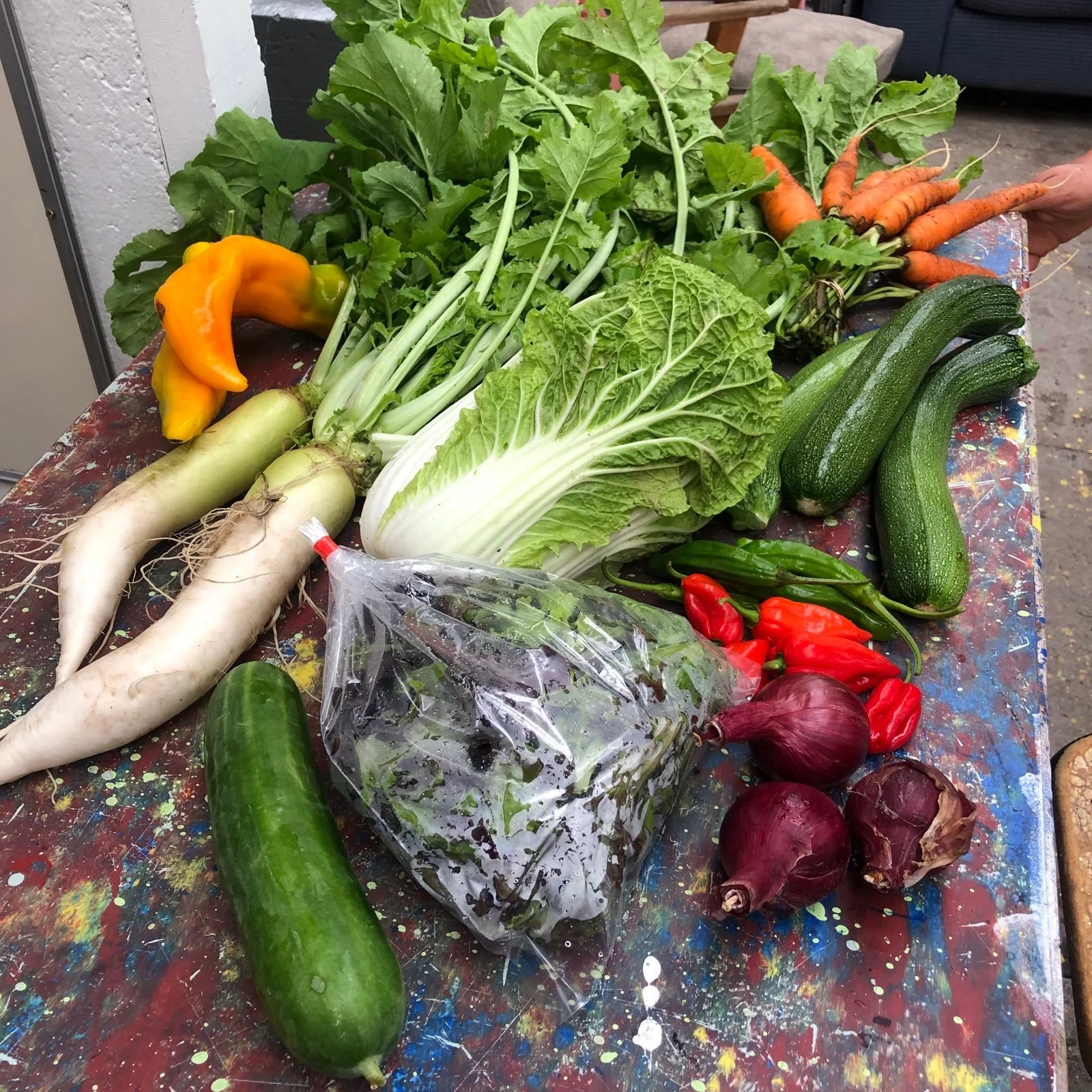Autumn Vege Bag - Week 6
Well, it’s finally happened. I’ve been foreshadowing the end of tomatoes a few weeks in a row, and it’s becoming more real this week. This is the first week in the last few months we won’t have tomato shares available for everyone, as the plants up at Crooked Vege are on their last legs, producing less than a quarter of what they were a month a go. So it goes - the first tomatoes of next summer will taste all the sweeter after the long season break.
Quite a few new things this week to try!
We have the first pumpkins and squash this week. These have been harvested a bit early, as they were fruit we spotted with skin-imperfections that risk turning into rot in the near future. Most of the squash and pumpkins will be cured and stored for slower-growing times ahead in winter.
If you like making hot sauce, we’ve got habaneros available - note that these are a much hotter chilli than the shishito we’ve had the last few weeks!
This week we have
Salad (from Ahoaho māra kai)
Zucchini (Ahoaho māra kai)
Carrots (Ahoaho māra kai)
Red Onions or Aubergine (Ahoaho māra kai)
Lebanese cucumbers and/or Chilli (Habanero or Shishito Chilli) (Crooked Vege)
Tomatoes or Bullhorn Capsicum (Crooked Vege)
Daikon (x2) or Herbs (Huacatay, Basil, Chives or Coriander) (Crooked Vege Ōtaki)
Nappa Cabbage, Squash (Burgess, Butternut or Red Kuri) or Crown Pumpkin half.
Vege highlights, tips & recipes
Huacatay
A very unusual but extremely delicious and unique herb. Huacatay is an extremely fragrant herb from the marigold family, and is used in peruvian cooking. The flavour is fruity, lime-y, minty, tarragon-y, yet totally it’s own thing. We first came across this herb a couple of years ago, smelling it in our friend’s market garden, Birdsong Farm. Birdsong Farm grow specialty herbs and oddities for high-end wellington restaurants, and saved us some seed from her crop as we were so excited about the flavour.
The two most common ways huacatay is used is in the peruvian sauces, Ocopa and Aji Verde.
Aji verde is made by blending huacatay, green chilli, lime, coriander (optional), garlic and parmesan or feta. Some recipes call for mayonnaise, which I suspect is an american-spin on the classic recipe.
Aji verde is great on chicken, lamb, roast veges, or simply as a dipping sauce.
I haven’t tried making Ocopa, which is typically eaten with potatoes. Here’s a seemingly typical recipe, it seems relatively similar to Aji Verde with less common ingredients - the chillis (aji amarillo & mirasol) it calls for aren’t easily available in New Zealand, so we’d need to subsitute with other chillis.
Nappa Cabbage
One of my favourite ever crops. Unfortunately we don’t grow it much at Crooked Vege - we have HEAPS of slugs, and they LOVE nappa cabbage. Each time slugs wipe out a months work of raising seedlings out overnight, we swear we won’t try grow it again. But every now and then we forget our promise to self and give it another go.
I like this more than more classic green or red cabbages. The texture is great in a stir fry (use at the end, so it doesn’t get overcooked!) or used raw in a salad. It’s super versatile.
My absolute favourite use for it, however, is making Kimchi. Which is why we’ve included daikon in this weeks bag..
Daikon
I first came across Daikon as a uni student with a a tight budget. 10 years ago, they were $1 each at the markets in Wellington, which seemed to be the best ratio of grams of food to money. Perhaps they’ve become trendy? Not long ago, I spotted them shrink wrapped in a Countdown for $6 each.
Daikon is commonly used in Japanese and Korean curry’s and soups.
But I’m excited about Kimchi.
Kimchi
Kimchi is a way more varied food than we think of in Aotearoa - in Korea there are hundreds of variations of kimchi that resemble nothing like what we think of here (e.g. fresh sweet kimchi). Kimchi loosely means something like “fermented” or “pickled.”
But we have the 2 main ingredients for the classic tongbaechu-kimchi that we’re familiar with in Aotearoa, nappa cabbage & daikon.
My favourite website for kimchi variations is maangchi.
I never make a kimchi exactly to any of these recipes, rather using what I have seasonally available, maybe replacing the korean chilli flakes with our own chillis, throwing in beetroot instead of carrots, garlic chives instead of spring onions etc.
The main thing to get from maangchi’s collection of recipes is the general process (usually salting & draining vegetables before making a paste to ferment them in), and the ratios to ensure there is the right amount of salt for safe fermentation. E.g. if I don’t have carrots, I’ll be sure to replace the 1 cup of carrots with 1 cup of something else of similar texture.
Habanero
These chillis are really quite hot. I used 1 in a 1L salsa and found that pretty hot! Habanero’s are very popular in the hot sauce industry, as the high heat lets hot sauce makers use other flavours to dominate the sauce. With milder chillis like Cayennes, the flavour of the chilli itself has to dominate the ingredients to have a ‘hot’ sauce. Additionally, they have a nice fruity flavour (behind the burning tongue spice) - hot sauce makers we know consider habaneros to be a better tasting chilli than famously super spicy chillis (like ghost peppers).
If you’re not into hot sauce, you could dry a bunch of habaneros and turn them into flakes/powder for winter. Mixing them with some dried red capsicum would give you a milder dried spice to use!
—
Ka kite ano,
Jon



